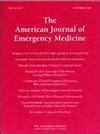种族、民族和语言与儿科急诊科分类不足的关系
IF 2.2
3区 医学
Q1 EMERGENCY MEDICINE
引用次数: 0
摘要
重要性急诊医学分诊不足影响护理提供的及时性。有限的研究检查了儿科分诊不足的差异。目的评估少数民族人群是否更容易出现分诊不足。设计/环境/参与者本队列研究分析了2021年7月1日至2024年9月16日在一级儿科创伤中心和区域转诊中心就诊的儿科患者。使用改进的德尔菲法定义临床重要的分类不足,即入院或接受静脉药物、雾化药物或氧气治疗的患者的紧急严重程度指数(ESI)评分为4或5分。暴露因素包括患者的种族、民族和护理人员的语言偏好。主要结局是临床上重要的分流。结果与NH黑人患者相比,NH白人患者更容易被分类不足(优势比[OR],2.0;95% ci, 1.7-2.3)。在多变量调整后,这种关联仍然显著(调整OR [aOR], 2.1;95% ci, 1.8-2.4)。同样,西班牙裔患者与NH黑人患者相比,分诊不足的几率更高(aOR, 1.7; 95% CI, 1.6-1.8)。患者和护理人员更喜欢西班牙语或其他非英语语言,这增加了分类失败的几率;(aOR,1.6; 95% CI, 1.5-1.7;aOR分别为1.5 (95% CI[1.1-1.9])。结论和相关性这些发现与先前的研究结果形成对比,这些研究表明NH黑人患者的分诊不足风险最高,并突出了护理差异的复杂性。需要进一步的研究,以更细致地了解导致不公平护理的因素。本文章由计算机程序翻译,如有差异,请以英文原文为准。
Race, ethnicity, and language association with Undertriage in Pediatric emergency medicine
Importance
Undertriage in emergency medicine impacts timeliness to care delivery. Limited research examines disparities in pediatric undertriage.
Objective
To assess whether minoritized populations are more likely to experience undertriage.
Design/Setting/Participants
This cohort study analyzed pediatric patient visits to a Level 1 Pediatric Trauma center and regional referral center from July 1, 2021, and September 16, 2024.Clinically important undertriage was defined using a modified Delphi approach, as Emergency Severity Index (ESI) scores of 4 or 5 in patients who were admitted or received intravenous medications, nebulized medications, or oxygen. Exposures were patient race, ethnicity and caregiver language preference. The primary outcome was clinically important undertriage.
Results
In comparison to NH Black patients, NH White patients were more likely to be undertriaged (odds ratio [OR],2.0; 95 % CI, 1.7–2.3). After multivariable adjustment, this association remained significant (adjusted OR [aOR], 2.1; 95 % CI, 1.8–2.4). Similarly, Hispanic patients had higher odds of undertriage compared to NH Black patients (aOR, 1.7;95 % CI,1.6–1.8). Patients and caregivers preferring Spanish or other non-English languages had increased odds of undertriage; (aOR,1.6;95 % CI,1.5–1.7; and aOR 1.5 (95 % CI [1.1–1.9]), respectively.
Conclusions and relevance
These findings contrast with prior studies suggesting NH Black patients are at highest risk for undertriage and highlight the complexity of care disparities. Further research is needed for a more nuanced understanding of the factors driving inequitable care.
求助全文
通过发布文献求助,成功后即可免费获取论文全文。
去求助
来源期刊
CiteScore
6.00
自引率
5.60%
发文量
730
审稿时长
42 days
期刊介绍:
A distinctive blend of practicality and scholarliness makes the American Journal of Emergency Medicine a key source for information on emergency medical care. Covering all activities concerned with emergency medicine, it is the journal to turn to for information to help increase the ability to understand, recognize and treat emergency conditions. Issues contain clinical articles, case reports, review articles, editorials, international notes, book reviews and more.

 求助内容:
求助内容: 应助结果提醒方式:
应助结果提醒方式:


